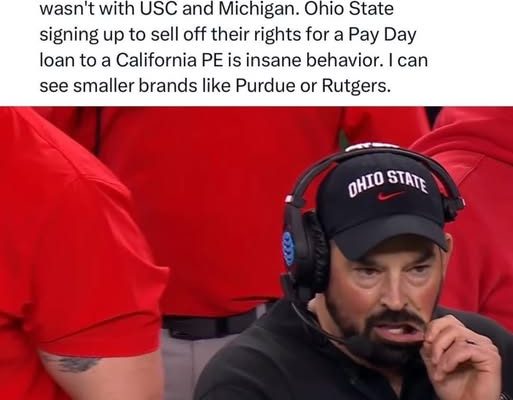The news that Ohio State University is reportedly exploring a potential deal with a private equity firm has sent shockwaves through the college sports world and beyond. For a program as prestigious, powerful, and financially successful as Ohio State, even the whisper of such a move sounds unthinkable. How could one of the most financially stable athletic departments in the country — one that generates hundreds of millions annually — even consider selling part of itself to Wall Street investors? It’s a question that’s forcing fans, alumni, and university stakeholders to confront the evolving reality of college athletics in 2025: the money game has changed, and no one, not even Ohio State, is immune.
To understand why this conversation is happening at all, you have to start with the transformation college sports has undergone in recent years. The rise of NIL (Name, Image, and Likeness) deals, the advent of direct athlete compensation, and the ongoing realignment of conferences have all turned college athletics into an open market more than an educational pursuit. Television contracts are measured in billions, athletes have agents, and schools are competing not just for championships but for financial sustainability. The NCAA’s previous amateurism model has effectively collapsed, leaving universities to find new ways to fund increasingly expensive programs.
In that context, the idea of private equity entering the college sports landscape — while controversial — is not entirely surprising. Investors see the massive, untapped commercial potential of college brands like Ohio State, Alabama, Michigan, and Texas. These programs have fan bases rivaling professional sports franchises, broadcast reach that spans continents, and brand loyalty that money can’t easily buy. To private equity, these are sleeping giants — under-monetized assets sitting inside nonprofit structures.
But for Ohio State, the question remains: why even entertain the idea? The Buckeyes boast one of the largest athletic budgets in the nation, regularly topping $250 million in annual revenue. Their football program alone generates tens of millions each fall, with television deals, ticket sales, and merchandise creating a steady stream of cash. The university’s athletic department is self-sustaining, meaning it doesn’t rely on general university funds or taxpayer money to operate. On paper, Ohio State should be the last school in America needing a financial bailout.
However, beneath the surface, the numbers are more complicated. The cost of competing at the top level of college football has exploded. Facilities arms races, escalating coaching salaries, NIL commitments, and recruiting budgets have created immense pressure even on powerhouse programs. To stay elite, Ohio State must constantly invest — not just in players and coaches but in infrastructure, media production, analytics, and brand building. The financial demands are relentless.
Then there’s the looming reality of athlete revenue sharing. Several lawsuits and legislative efforts are pushing for college athletes, particularly football and basketball players, to receive a formal share of the revenue their programs generate. If this becomes law — as many predict it will — universities could be forced to pay players directly, potentially costing tens of millions per year. For even the wealthiest athletic departments, that’s a seismic shift. Suddenly, “self-sustaining” doesn’t mean what it used to.
In that light, a deal with private equity might not look like desperation, but preparation. The idea, reportedly discussed internally at Ohio State and other major programs, would involve selling a minority stake in the athletic department’s commercial rights to a private investor. In exchange, the university would receive a massive upfront payout — potentially hundreds of millions — to bolster NIL funding, upgrade facilities, and ensure long-term financial stability. It’s the same model professional leagues have explored, with firms like Arctos Sports Partners and Silver Lake already investing in NBA, MLB, and European soccer clubs.
The problem, of course, is that universities are not pro teams. They are public institutions, accountable not to shareholders but to students, faculty, and the state. Selling part of their athletic identity to Wall Street investors raises profound ethical and practical questions. Would Ohio State still control its brand and values? What happens when investor expectations clash with academic or community goals? Would ticket prices rise? Would traditions be sacrificed for profit?
These concerns aren’t hypothetical. Critics argue that private equity’s influence would erode the educational mission of college sports, turning programs into corporate entertainment products. Investors, by nature, seek returns. If profits drive decision-making, everything from scheduling to athlete treatment could be impacted. The soul of college athletics — built on loyalty, spirit, and amateur ideals — could be traded for spreadsheets and quarterly earnings reports.
At the same time, proponents insist that adaptation is necessary. They argue that universities must evolve or be left behind in a rapidly professionalizing environment. With the Big Ten’s media deals surpassing $7 billion and the College Football Playoff expanding, the financial stakes have never been higher. Schools that fail to modernize their revenue strategies could lose ground to rivals who do. For Ohio State, staying at the top may mean thinking like a business, even if that feels uncomfortable.
There’s also a broader societal shift at play. The boundaries between college and professional sports are blurring fast. Players are signing endorsement deals, transferring freely, and negotiating contracts through collectives. Fans already treat programs like Ohio State more like NFL franchises than campus clubs. In that world, private investment doesn’t seem quite as shocking. It’s simply the next step in the commercialization of college athletics.
Still, the symbolism of Ohio State — a storied, tradition-rich powerhouse — partnering with private equity would hit differently. This isn’t a struggling mid-tier school trying to stay afloat. It’s one of the crown jewels of college football, a program that defines Saturday afternoons in America. If Ohio State starts selling pieces of itself, it sends a message: the age of pure college sports is officially over.
The reaction from fans and alumni has been predictably mixed. Many are furious at the mere suggestion, calling it a betrayal of the university’s values. They see private equity as a threat to everything Ohio State stands for — community, tradition, and pride. Others, however, are more pragmatic. They point to the realities of the modern sports economy and argue that this might be the only way to ensure Ohio State remains competitive long-term. In a world where even small advantages matter, financial flexibility could be the difference between national titles and second place.
Inside the athletic department, the mood is reportedly cautious but curious. Athletic Director Gene Smith, long known for his business acumen, has publicly acknowledged the need to explore creative solutions to the evolving financial model of college sports. That doesn’t mean a deal is imminent — or even likely — but it shows that nothing is off the table anymore. Universities across the Big Ten and SEC are quietly watching what Ohio State does next. If the Buckeyes move forward, others will surely follow.
It’s easy to forget that Ohio State, for all its power, is still part of a public university system with political oversight. Any major financial partnership would need approval from the university’s board and likely the state government. That process alone would be lengthy and contentious. Lawmakers would face enormous pressure from constituents who see college football as sacred. The debate wouldn’t just be about money — it would be about identity.
In truth, Ohio State’s flirtation with private equity is less about financial crisis and more about financial evolution. The Buckeyes aren’t broke; they’re bracing for a future that looks very different from the past. The traditional model — boosters, ticket sales, and TV contracts — may not be enough to sustain the escalating costs of modern college sports. Private capital, for all its risks, offers immediate resources and flexibility. It’s a tempting proposition in an increasingly competitive marketplace.
The irony is that the very success of programs like Ohio State has helped create the financial arms race they’re now struggling to manage. The pursuit of excellence — bigger stadiums, flashier facilities, higher-paid coaches — has driven athletic departments to expand beyond what old revenue streams can support. Now, to maintain that same excellence, they might have to make deals that redefine what it means to be a college program.
For fans, the question is both emotional and existential: what happens when your team — your school — becomes a business investment? Can you still believe in the idea of playing for the love of the game, for pride and tradition, when private money is calling the shots? Or has that idea already faded, replaced by the realities of modern competition?
Perhaps the most striking thing about this entire conversation is how normal it now seems. Ten years ago, the notion of Ohio State selling a stake to investors would have been dismissed as absurd. Today, it’s a legitimate topic of discussion. That tells you everything about where college sports is headed.
If Ohio State ever takes that step, it will mark a turning point — not just for the Buckeyes, but for the entire landscape of collegiate athletics. The era of booster clubs and alumni donations would give way to an age of capital markets and corporate partners. The fight song might still play, the scarlet and gray might still wave, but the foundation beneath it would be irrevocably changed.
For now, Ohio State insists that no formal negotiations have taken place and that the university remains committed to its values and traditions. But the fact that such discussions are even on the table suggests that the winds of change are blowing stronger than ever. Whether this is the beginning of a new financial frontier or the beginning of the end for college sports as we know them will depend on what happens next.



